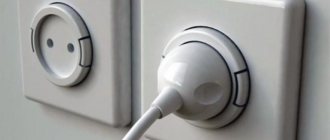Characteristics of electrical equipment - power and current consumption. If only one of these quantities is indicated, then it is necessary to convert amperes to kilowatts. These conversions are needed to determine the ratings of circuit breakers and select the cross-section of supply conductors, calculate and design the power supply system, and account for consumed electricity.
All the necessary concepts for calculations are available in the school physics course, with the exception of the nuances of using reactive load. How many amperes in a kilowatt is determined for direct and alternating current equally, provided that active consumers are used. Inductive or capacitive loads require power factor considerations. There are several formulas for converting amperes to kilowatts, and they do not require complex calculations.
How to find a phase in an outlet, and why three-phase ones are needed; how to measure voltage and determine current
Often, when making any changes to the electrical wiring, it becomes necessary to determine the phase wire. Regardless of the voltage in the outlet, according to modern standards they must be color-coded. So the yellow-green wire is ground, and the blue or cyan wire is zero. Accordingly, the rest (one or three) are a phase; usually phase wires are:
- according to standards before 2011 – yellow, green, red;
- after 2011 – brown, black, gray.
However, in some networks installed before 2011, the black wire was used for grounding. In addition, in single-phase wiring it is customary to connect the phase on the right.
If any markings are missing, then a probe with a neon lamp will be useful. When you touch a phase, the indicator will light up. If a probe with an LED is used, do not touch the metal pad at the end of the handle with your hand when testing. To determine how much current is in the outlet, you need a voltmeter. It is also useful in determining the phases of a three-phase connection. So between each phase and zero there will be 220V at a linear voltage of 380V and 127V at a linear voltage of 220V (but the latter connector is practically never found or used today). In household networks, a three-phase connection can be used for kitchen stoves with high-power electric ovens. Terminal boards in some models thus allow the load to be evenly distributed.
380 volt networks
Converting current values into power for a three-phase network does not differ from the above, it is only necessary to take into account the fact that the current consumed by the load is distributed over three phases of the network. The conversion of amperes to kilowatts is carried out taking into account the power factor.
In a three-phase network, you need to understand the difference between phase and line voltages, as well as line and phase currents. There are also 2 options for connecting consumers:
- Star. 4 wires are used - 3 phase and 1 neutral (zero). The use of two wires, phase and neutral, is an example of a single-phase 220 volt network.
- Triangle. 3 wires are used.
The formulas for converting amperes to kilowatts for both types of connection are the same. The only difference is in the case of a delta connection for the calculation of separately connected loads.
Star connection
If you take a phase conductor and a neutral conductor, then there will be a phase voltage between them. The voltage between phase wires is called linear, and it is greater than the phase one:
Ul = 1.73•Uph
The current flowing in each of the loads is the same as in the network conductors, therefore the phase and line currents are equal. Provided the load is uniform, there is no current in the neutral conductor.
The conversion of amperes to kilowatts for a star connection is made using the formula:
P=1.73•Uл•Iл•cosø
Formula for calculating the current in a socket
I=P/(U*cos f) , where I – Current (ampere), P – power of connected equipment (W), U – network voltage (Volts), cos f – power factor (if this indicator is not in the characteristics equipment, take 0.95)
Let's calculate using this formula how many amperes the current is in a regular home socket with a voltage (U) of 220V when connecting an iron with a power of 2000 W (2 kW) to it, the cos f of the iron is close to 1.
This means that when the iron with a power of 2 kW is turned on and heated, the current in the outlet will be about 9.1 Amperes.
When several devices are simultaneously plugged into one outlet, the current in it will be equal to the sum of the currents of this equipment.
More information about choosing and installing a socket
If the required current in an outlet is 1 ampere, how many volts should it contain?
Ampere and volt are different physical quantities. A volt (V) is the voltage required to push 1 C (coulomb) of electricity through a network. Ampere (A) is the strength of electric current in a conductor, showing how many coulombs pass through the conductor in 1 second. If the current in a conductor is 1 Ampere, this means that in 1 second it passes a charge of electricity equal to 1 C.
If the current strength is multiplied by the network voltage, then in the end we get an indicator of its power. For example:
Normal household voltage - 220 V
Electrical power = 220 V*1 A = 220 W (Watt)
Therefore, the question of how many volts are in an ampere does not sound entirely correct. The correct wording is: “What power (in watts) does an electrical appliance develop that consumes a current of 1A?”
The answer to it will sound like this: “An electrical device that consumes a current of 1A, when connected to a household power supply with a voltage of 220V, will develop a power of 220 W.”
Formulas for calculating the current and power of the power line are presented in the figure below.
How to choose an outlet for your home?
A socket is a device for connecting household appliances to the electrical network. It consists of a housing and a block, to the contacts and terminals of which the current-carrying wires are connected.
There are household and industrial sockets. According to the standards, the average voltage is 220V in a household outlet. The permissible current for such an outlet is 10A-16A, which is suitable for connecting a device with a power of 3520 W. When installing equipment with higher power, the contacts become very hot, and the possibility of fire increases. For an 8 kW electric stove, a regular outlet that can withstand a current of 16 A will not work.
What is the current strength in a 220V and 380V outlet, and what household appliances require 16, 25 and 32 amperes?
Today, every person knows how many volts are in an outlet. The standard voltage in domestic household electrical networks is 220 volts. In some countries, a different standard has been adopted and there it can be 127 or 250 volts. Most modern technology is designed specifically for such indicators. However, in addition to voltage, when installing wiring, it is necessary to take into account the expected power of the connected consumers. So today, 220 volt sockets with a load limit of 16A and 25A are on sale. They are used for different purposes. Since the current in a 220V outlet is directly proportional to the power consumption of the equipment connected to it.
Formula for calculating current by power and voltage
POWER = CURRENT * VOLTAGE, that is, WATTS = AMPERES * VOLTS.
There are several more important points if we are talking about electricity.
1. Standard outlets are rated at 16 Amperes. Since the network voltage is 220 Volts, the maximum power is 16 Amperes * 220 Volts = 3,520 Watts or 3.5 Kilowatts. 2. As a rule, 16 Amp circuit breakers are installed on the line of sockets. What does it mean? If on the line where the 16 Ampere circuit breaker is installed, the current strength is more than 16 Amperes (or power more than 3.5 kilowatts), the circuit breaker will trip. For example, in your apartment there is a separate line for kitchen sockets. If you connect two heaters to this line, each with a power of 2 kW, the machine will open the circuit.
A socket is an electrical equipment without which it is impossible to imagine a living or working space today. Since the equipment used is different, the characteristics of the electrical accessories for it will also differ. It's no secret that the power of modern household appliances is slightly higher than 2-3 decades ago. That is why GOST standards were changed. Thus, for Soviet connectors, the standard load limit was 6A in networks with a voltage of 220V, but today it has been increased to 16A. For large loads, three-phase networks with a voltage of 380V are supplied. The 3-phase socket is different in design and can withstand loads up to 32A.
What is the maximum amperage for sockets?
Most often, modern 220V home sockets are designed for a maximum current of 10 or 16 Amperes . Some manufacturers claim that their sockets can withstand 25 Amps , but there are very few such models.
Old, Soviet sockets, which are still found in our apartments, are generally designed for only 6 Amperes.
The maximum that you can find in a standard typical apartment is a power outlet for an electric stove or hob, which can withstand current up to 32 Amperes.
These are manufacturer-guaranteed indicators of the current strength that the socket will withstand and not be destroyed. These characteristics are necessarily indicated either on the socket body or on its mechanism.
When choosing electrical installation products, keep in mind that, for example, a 16 Ampere outlet will withstand about 3.5 kilowatts of power, and a 10 Ampere outlet will only handle 2.2 Kilowatts. Below is a table of the maximum power of connected equipment for outlets, depending on the number of amperes for which they are designed.
TABLE OF MAXIMUM EQUIPMENT POWER FOR 6, 10, 16, 32 Amp Outlets
Most often, all household electrical equipment that is plugged into standard 220V sockets does not exceed 3.5 kW in power; more powerful devices have different connectors for connection or are supplied without an electrical plug, designed to be connected to terminals or to electrical plugs for power sockets .
I advise you to always choose sockets designed for a current of 16 Amps or more - they are more reliable. After all, most often electrical wiring in apartments is laid with copper cable with a core cross-section of 2.5 mm2. and place the machine on 16 Ampere sockets. Therefore, if you choose an outlet rated for 10 Amperes and connect a large load to it, the automatic protection will not work, and the outlet will begin to heat up and melt, which may cause a fire.
Safety precautions when measuring voltage
Since, depending on the safety class of the room and its condition, even relatively low voltages of 12–36 V can pose a danger to life, the following rules must be followed:
- Do not carry out voltage measurements that require certain professional skills (over 1000 V).
- Do not measure voltages in hard-to-reach places or at heights.
- When measuring voltages in a household network, use special means of protection against electric shock (rubber gloves, mats, boots or boots).
- Use a proper measuring tool.
- In the case of using multifunctional instruments (multimeters), ensure that the parameter being measured and its value are correctly set before measurement.
- Use a measuring device with working probes.
- Strictly follow the manufacturer's recommendations for using the measuring device.
Literature
Author of the article: Sergey Akishkin
Voltage measurement
Voltage measurement plays an important role in fundamental physics and chemistry, applied electrical engineering and electrochemistry, electronics and medicine, and in many other branches of science and technology. It is perhaps difficult to find branches of human activity, excluding creative fields such as architecture, music or painting, where voltage measurements would not be used to control ongoing processes using various types of sensors, which are essentially converters of physical quantities into voltage. Although it is worth noting that in our time these types of human activities cannot do without electricity in general and without voltage in particular. Artists use tablets that measure the voltage of capacitive sensors when a stylus is moved over them. Composers play electronic instruments that measure the voltage on the key sensors and, depending on it, determine how hard a particular key is pressed. Architects use AutoCAD and tablets, which also measure voltage, which is converted into a numerical form and processed by a computer.
A kitchen thermometer (left) measures the temperature of meat by measuring the voltage across a resistive temperature sensor through which a small current is passed. In a multimeter (right), temperature is determined by measuring the voltage directly across the thermocouple
The measured voltage values can vary widely: from fractions of a microvolt in studies of biological processes, to hundreds of volts in household and industrial devices and appliances, and up to tens of millions of volts in ultra-powerful particle accelerators. Voltage measurement allows us to monitor the condition of individual organs of the human body by taking encephalograms
brain activity.
Electrocardiograms
and
echocardiograms
provide information about the condition of the heart muscle. Using various industrial sensors, we successfully, and most importantly, safely, control chemical production processes, which sometimes occur at extreme pressures and temperatures. And even nuclear processes at nuclear power plants can be controlled by measuring voltages. Using stress measurements, engineers monitor the condition of bridges, buildings and structures and even withstand such formidable natural forces as earthquakes.
A pulse oximeter, like a voltmeter, measures the voltage at the output of a device that amplifies the signal from a photodiode or phototransistor. However, unlike a voltmeter, here on the display we see not the voltage value in volts, but the percentage of hemoglobin saturation with oxygen (97%).
The brilliant idea of connecting different values of voltage levels with the state values of units of information gave impetus to the creation of modern digital devices and technologies. In computing, a low voltage level is interpreted as a logical zero (0), and a high voltage level is interpreted as a logical one (1).
In fact, all modern computing devices are, to one degree or another, voltage comparators (meters), converting their input states according to certain algorithms into output signals.
Among other things, accurate voltage measurements form the basis of many modern standards, the implementation of which guarantees their absolute compliance and thus safety of use.
The memory board used in personal computers contains tens of thousands of logic gates.










